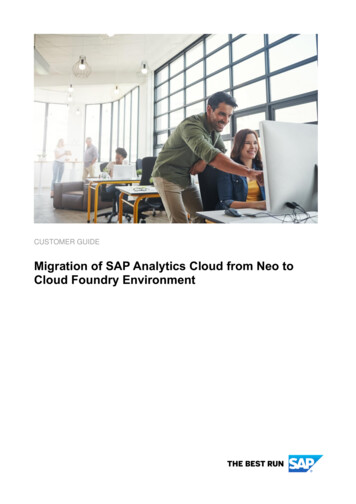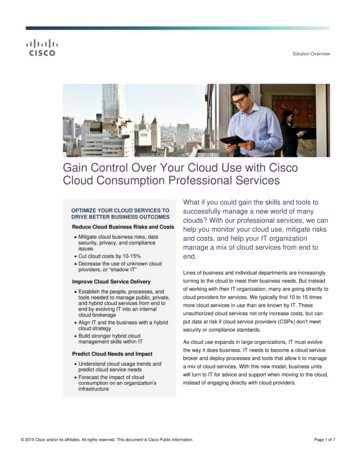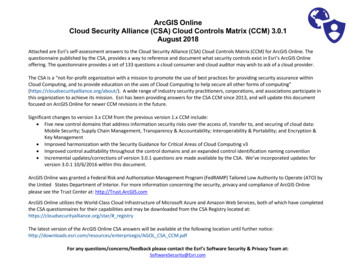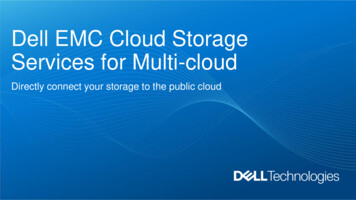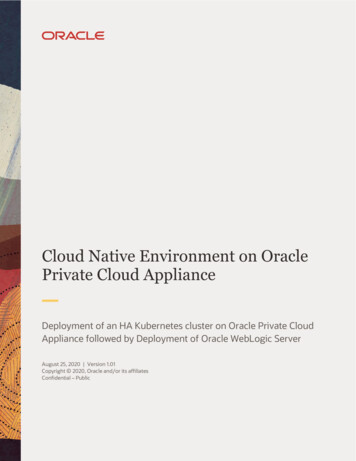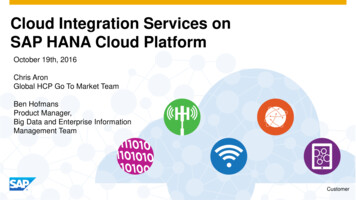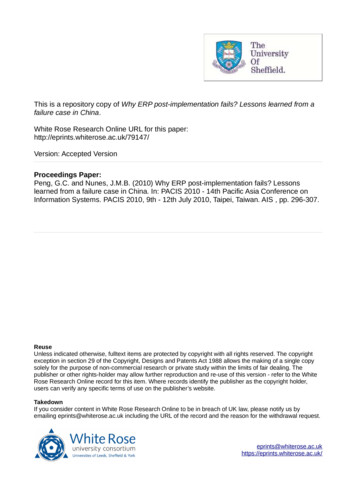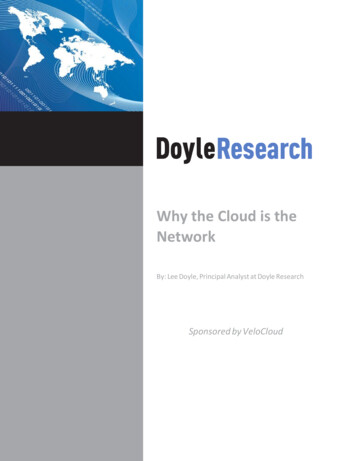
Transcription
Why the Cloud is theNetworkBy: Lee Doyle, Principal Analyst at Doyle ResearchSponsored by VeloCloud
Executive SummaryMission critical enterprise applications are moving to the cloud, driving the need forwide area network (WAN) agility, flexibility, and rapid scalability. Leading IT trends suchas Software as a Service (SaaS), Cloud storage, Enterprise mobility, and globalizationincrease the importance of network assets. However, the advantages of public andprivate data centers are diminished if the network is slow, inflexible, and unpredictable.Erratic network performance with high latency, jitter and packet loss can significantlyimpact user adoption, satisfaction, and productivity.End users are increasingly distributed from remote branch offices and need to accesscorporate applications and data 24/7/365 from multiple devices. The Internet provides aglobal access for cloud applications, but is limited by poor reliability, unpredictableperformance, and weak security. The solution is to put network intelligence in the cloudto control traffic flows, orchestrate centrally and leverage multiple links (e.g. hybridWAN) for reliability.The increased deployment of cloud applications, storage, hosted voice, video, andmobile applications has challenged IT and business managers to provide high qualityWAN services to the branch. Deploying and managing the WAN has become morechallenging and costly as traffic flows decentralize. The solution for many organizationsis to place network intelligence in the cloud to monitor, steer, and secure traffic flows.SD-WAN offers compelling advantages for distributed organizations with critical branchoperations, including the benefits of business agility, improved application performance,and lower cost of bandwidth.Trends in Cloud AdoptionThe adoption of cloud computing, cloud storage, and SaaS has rapidly changed the wayusers access applications and data. As the functionality, security, and performance ofSaaS applications has improved, the usage of popular SaaS applications likeSalesforce.com, Google Docs, and Microsoft Office 365 has skyrocketed. Every daymillions of workers access cloud services such as Amazon Web Services and MicrosoftLee Doyle Doyle Research ldoyle@doyle-research.com 2015 Doyle Research2
Azure, cloud-based storage (e.g. Box and Drop Box), unified communications services(e.g. Ring Central, Vonage Business, Skype for Business) and conferencing applicationslike Go-to-Meeting and WebEx.Industry analysts expect the use of cloud-based computing and applications to growstrongly over the next five years. Research conclusions include: IDC predicts that worldwide spending on public IT cloud services will grow from 56.6 billion in 2014 to more than 127 billion in 2018. According to Okta Research, most organizations currently use between 11-16 offthe-shelf cloud applications. IDC predicts that more than 80 percent of new applications will be deployed viathe cloud and that cloud platforms will gradually displace the client/serverapproach as the dominant model for application delivery.The reality is that the majority of the workforce (approximately 70%) is located far fromcorporate headquarters either at branch offices or at remote/home offices. All ITorganizations need to provide branch users with fast, reliable, secure access as theyincrease their use of cloud-based applications.The Cloud is an Ideal Platform for the WANThe growth in globalized business operations, increasingly dynamic remote offices, andadoption of cloud-hosted apps and data have created new challenges for IT managerstasked with providing secure, reliable access to cloud-based applications. End-userexperience and satisfaction are directly related to a network’s responsiveness, so ITdepartments must concern themselves with latency, packet loss, and jitter if they aregoing to ensure consistent performance for critical cloud-based applications. With thedistribution of branch offices (everywhere) and the distribution of cloud-basedapplications (everywhere), IT organizations must adopt new strategies for deliveringWAN connectivity.Due to rigid architectures, complexity, and cost concerns the traditional model ofconnecting branch office users to a centralized data center via T1s, Frame Relay, orLee Doyle Doyle Research ldoyle@doyle-research.com 2015 Doyle Research3
MPLS cannot scale to meet these needs. Employees (and customers) need to connect tocloud-based applications directly via high speed Internet access. The new WAN requiressolutions that leverage the benefits of the Internet (speed, ubiquity) with a fabric toconnect distributed users to distributed applications. Network intelligence based in thecloud can remediate network (Internet) challenges to reduce jitter, packet loss, andimprove redundancy. By providing diversity in network access and re-routing trafficwhen necessary, an intelligent network can improve reliability.Security is a critical concern due to the distributed nature of cloud applications andremote users who can no longer be controlled by IT. As the security perimeters breakdown, security and policies need to be embedded within the network. A new WANprovides enhanced security by monitoring and applying policies across network traffic,applications and users.The solution for organizations with a distributed work force is to deploy softwaredefined wide area network (SD-WAN) solutions – see Figure 1. SD-WAN solutionsconsist of centrally managed WAN edge (physical or virtual) devices deployed in branch(or remote) offices. SD-WAN provides the following capabilities: Leverages the abundant availability of ordinary broadband links like Cable and DSLto augment the existing MPLS to connect efficiently to the Cloud resources Simplifies business operations for all remote employees to access cloud resourceswithout hair-pinning through the corporate datacenter Centralize and orchestrate the branch office WAN network via a cloud console andeliminate the need for truck rolls to implement branch network changes Deploy secure connectivity to all branch offices and simplify the setup of site-to-siteVPNs Deliver link quality remediation over private and public transport Enable bi-directional quality of service across public transport (such as Internet)directly to and from cloud applications, compute, storage and Internet applications Leverage cloud hosted services for scalable, redundant connectivity to bothenterprise and cloud datacenters without network reconfigurationLee Doyle Doyle Research ldoyle@doyle-research.com 2015 Doyle Research4
SD-WAN technology delivers the network intelligence required to connect an increasingremote work force with cloud-based applications and data.Figure 1: Cloud Enabled WANSD-WAN Use CasesCloud-based WAN solutions are installed in a number of use cases across differentverticals including: Hybrid WAN: Organizations migrate to SD-WAN by adding Internet circuits totheir existing MPLS networks to improve available network bandwidth and toprovide faster access to cloud resources for remote branch users. Thisarchitecture also improves reliability and reduces bandwidth costs. Unified Communications: IT organizations faced with inconsistent UC or videoexperience are leveraging the benefits of hosted voice and video with the SDWAN traffic steering and packet conditioning capabilitiesLee Doyle Doyle Research ldoyle@doyle-research.com 2015 Doyle Research5
Temporary Office Access: Organizations, such as retail and construction, areconstantly provisioning remote office access to pop-up retail stores and newconstruction sites. SD-WAN’s ability to quickly and easily provision secure WANconnectivity via Internet links is ideal for rapid Internet access.VeloCloud SD-WAN SolutionFounded in 2012, VeloCloud is a cloud networking provider based in Mountain View, CA.VeloCloud has helped a number of existing customers across multiple vertical industrieswith their WAN challenges. Its architecture consists of the following: Edges and Virtual Edges installed in branches and datacenters Gateways offered as a service by VeloCloud and its provider partners at toptransit POPs and cloud datacenters around the world. Gateways provide SD-WANfunctionality for both on-premise and cloud-based sites. Cloud Orchestrator provides centralized configuration, real-time monitoring andcontrol plane automation The solution is delivered as both a service subscription and more traditionalpurchase modelVeloCloud’s solution provides a broad SD-WAN feature set including automationapplication recognition and categorization for traffic prioritization, dynamic WAN circuitand path selection and remediation, and ease of deployment, management, andchange. See Figure 2 for an overview of VeloCloud’s SD-WAN architecture.VeloCloud partners include: Security partnerships with Zscaler and Websense IT partnership with HP’s Open NFV alliance and Intel NetBuilders Cloud infrastructure partnerships with Equinix and IIXLee Doyle Doyle Research ldoyle@doyle-research.com 2015 Doyle Research6
Figure 2: VeloCloud ArchitectureConclusions and Recommendations for CustomersThe increased popularity of cloud-based platforms, including compute, storage, UC,conferencing, and other popular applications is changing WAN requirements. The newWAN must be able to connect any user to any application reliability, securely, and withnear real time response (low latency). Network intelligence based in the cloud enablesIT organizations to quickly, easily, and securely adapt their network to the new cloudoriented traffic flows. It provides the ability to leverage the advantages of Internetconnectivity (high speed, low cost, wide availability) while minimizing the disadvantages(unpredictable reliability, poor latency, and limited security).Lee Doyle Doyle Research ldoyle@doyle-research.com 2015 Doyle Research7
SD-WAN provides new features that better handle changing network traffic patternsresulting from cloud computing and provides a dramatically simplified way of deployingand managing remote branch office connectivity in a cost-effective manner. SD-WANeliminates the backhaul penalties of traditional MPLS networks and leverages theInternet to provide secure, high performance connections from the branch to cloud.With SD-WAN, remote users will see significant improvements in their experience whenusing the Cloud/SaaS-based applications.SD WAN technology is currently in use of a number of interesting use cases, including: Hybrid WAN (MPLS and Internet)Internet-only WANUnified communication/video quality over the top of InternetTemporary, secure WAN accessSD-WAN will help IT organizations transition from MPLS only networks to hybrid WANwhile leveraging Internet economics. Organizations with a distributed workforce whichaccess cloud-based applications should consider the adoption of SD-WAN solutions.Meet the AuthorLee Doyle is Principal Analyst at Doyle Research, providing client focusedtargeted analysis on the Evolution of Intelligent Networks. He has over 25 years’experience analyzing the IT, network, and telecom markets. Lee has writtenextensively on such topics as SDN, NFV, enterprise adoption of networkingtechnologies, and IT-Telecom convergence. Before founding Doyle Research, Leewas Group VP for Network, Telecom, and Security research at IDC. Leecontributes to such industry periodicals as Network World, Light Reading, andTech Target. Lee holds a B.A. in Economics from Williams College.Lee Doyle Doyle Research ldoyle@doyle-research.com 2015 Doyle Research8
Security partnerships with Zscaler and Websense IT partnership with HP’s Open NFV alliance and Intel NetBuilders Cloud infrastructure partnerships with Equinix and IIX




